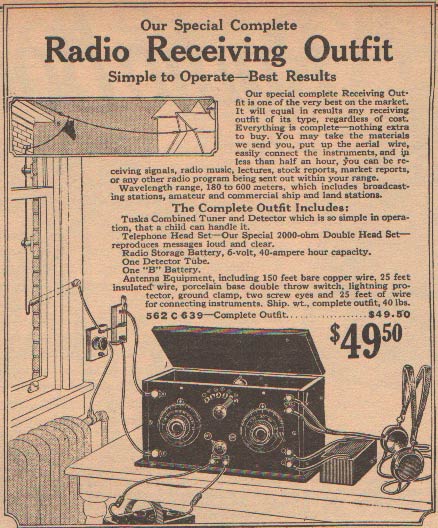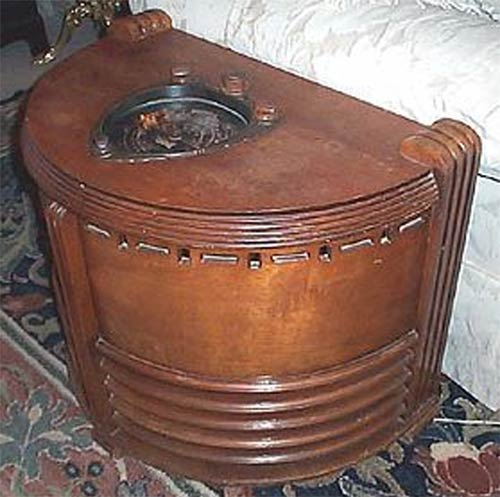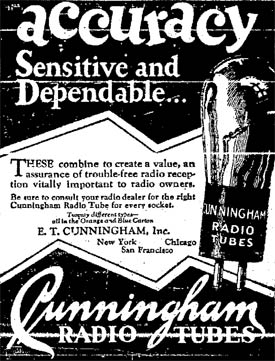|
1922 Radio Set as Offered by Montgomery Ward Catalog (Source: Webmaster)
 |
Radio was a big deal in the 1920s and 30s. Broadcast radio receiving technology of the era was mostly low-frequency, amplitude-modulated equipment. Said equipment was large and heavy, and was tube-based and battery-powered, and required a long wire antenna to operate. At right, is an advertisement for a household receiving set offered in the 1922 Montgomery Ward catalog.
Note the top of the "One Detector Tube' lurking through the open enclosure, and the wiring and connections at left to the external antenna and to ground (the radiator). The storage battery for power is at the very bottom, under the table.
Interestingly, in the Montgomery Ward catalog that year there was only one page devoted to radio equipment, and the "outfit" shown at right was the only one offered for sale complete.
The rest of the page was occupied by ads for radio parts and supplies of the types that would be used to build a radio from scratch. For example, inductance coils of various tuning ranges, potentiometers, wood cabinets, tubes, condensers and headsets. Do-it-yourself radio was popular. The radio jacks and plugs, as well as wire binding posts, are of the same design you can buy at electronics suppliers today. Some designs changed; some are that enduring.
Galena Crystal
 |
They also sold standard galena detector housings for positioning a crystal of mineral galena (lead sulfide) as a tuning device, thus assigning the name "crystal radio." At left, a chunk of galena crystal used as a detector. Building crystal radios was a popular radio hobbyist project of the 1930s, and many boys in scouting built one.
Below is a popular console-style radio, which fit nicely next to a chair to hold a newspaper, ashtray or cocktail. This radio model is owned by Your Webmaster.
Zenith Model 6S249 Console Radio (Source: Webmaster)
 |
The New Years Day newspaper article below summarizes nicely the state of the art and predictions for the future.
The New York Times, January 1, 1928 (Source: The New York Times)
 |
Radio Tube Advertisement, 1927 (Source: Web)
 |
At left, an advertisement for Cunningham radio tubes. The development and proliferation of commercial broadcast radio spawned a number of new businesses, including radio set design and manufacture, tube manufacure and supply, tube testing consoles, and radio sales and repair stores. As with the automobile a couple of decades earlier, there was a shift in the infrastructure and supply chain to accomodate the developing technology, which contributed to the earning power of engineers, transporters, merchants and technicians.
As with commercial radio, aviation radio was in its developmental stages. Register pilots were fully involved with that development. For example, Clarence Culver experimented with communications. And Albert Hegenberger and William C. Ocker were involved with the development of navigation radio technologies and techniques.
---o0o---
THIS PAGE UPLOADED: REVISED:
|
